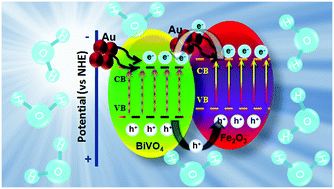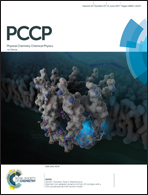Enhanced photoelectrochemical response of plasmonic Au embedded BiVO4/Fe2O3 heterojunction†
Abstract
The effect of embedding Au nanoparticles (NPs) in a BiVO4/Fe2O3 heterojunction for photoelectrochemical water splitting is studied here for the first time. The present nanostructured heterojunction offers three major advantages over pristine BiVO4 and Fe2O3: (i) the formation of a heterojunction between BiVO4 and Fe2O3 enhances the charge carrier separation and transfer, (ii) the layer of Fe2O3 provides protection to BiVO4 from photocorrosion and, (iii) the Au NPs possessing surface plasmon resonance (SPR) enhance the photoelectrochemical response by transferring energy to metal oxides by hot electron transfer (HET) and plasmon resonant energy transfer (PRET). The present study reveals that the heterojunction ITO/BiVO4/Fe2O3 (with 32% v/v Au solution in both layers) gives the best performance and mitigates the limitations of both pristine Fe2O3 and BiVO4. A thirteen-fold increment in applied bias photon-to-current conversion efficiency (ABPE) was observed at 1.24 V vs. RHE under the condition of 1 Sun illumination. Monochromatic incident photon-to-current conversion efficiency (IPCE) measurements indicated that an Au embedded heterojunction is more effective in harvesting visible light in comparison to a heterojunction without Au NPs.



 Please wait while we load your content...
Please wait while we load your content...